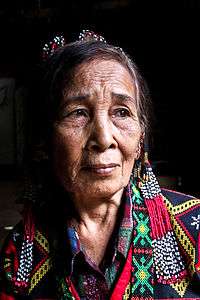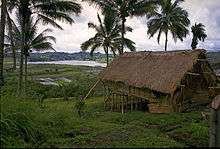Tboli people
The Tboli people (IPA: ['tʔbɔli]) are one of the indigenous peoples of South Cotabato in Southern Mindanao. The body of ethnographic and linguistic literature on Mindanao, they are variously known as Tboli, T'boli, Tböli, Tagabili, Tagabilil, Tagabulul and Tau Bilil. They term themselves Tboli. Their whereabouts and identity are somewhat imprecise in the literature; some publications present the Tboli and the Tagabili as distinct peoples; some locate the Tbolis to the vicinity of the Lake Buluan in the Cotabato Basin or in Agusan del Norte. The Tbolis, then, reside on the mountain slopes on either side of the upper Alah Valley and the coastal area of Maitum, Maasim and Kiamba. In former times, the Tbolis also inhabited the upper Alah Valley floor. After World War II, i.e., since the arrival of settlers originating from other parts of the Philippines, they have been gradually pushed onto the mountain slopes. As of now, they are almost expelled from the fertile valley floor.
 A Tboli elderly woman in traditional attire. | |
| Total population | |
|---|---|
| 144,951[1] | |
| Regions with significant populations | |
| Languages | |
| Tboli, Cebuano, Hiligaynon, Tagalog | |
| Religion | |
| Christianity, Animism (Anitism) | |
| Related ethnic groups | |
| Austronesian peoples, Lumad, and Sama-Bajau peoples |


Like their immediate tribal neighbors, the Úbûs, Blàan, Blit, Tàú-Segél, and the Tasaday, they have been variously termed hill tribes, pagans, animists, etc., as opposed to the indigenous Muslim peoples or the Christian settlers. In political contexts, however, the term Lumad groups (derived from the Cebuano term for native people) has become popular as a generic term for the various indigenous peoples of Mindanao.
Musical
The Tboli have a musical heritage consisting of various types of agung ensembles – ensembles composed of large hanging, suspended or held, bossed/knobbed gongs which act as drone without any accompanying melodic instrument.
Indigenous Tboli religion
The T'boli people believe in a highly-complex traditional religion that is unique to the region. Their religion is regionally-complex and is composed of the life ways and belief systems inherent to the Tboli psyche. However, in modern times, their religion has been degraded to a certain extent due to the introduction of Roman Catholicism, Protestanism, and Islam. Nevertheless, some communities continue to preserve and conserve the religion practices of their ancestors, which has been established thousands of years ago.
Immortals
- Bulon La Mogoaw: one of the two supreme deities; married to Kadaw La Sambad; lives in the seventh layer of the universe[4]
- Kadaw La Sambad: one of the two supreme deities; married to Bulon La Mogoaw; lives in the seventh layer of the universe[5]
- Cumucul: son of the supreme deities; has a cohort of fire, a sword and shield; married to Boi’Kafil[6]
- Boi’Kafil: daughter of the supreme deities; married to Cumucul[7]
- Bong Libun: daughter of the supreme deities; married to S’fedat; could not bear children[8]
- S’fedat: son of the supreme deities; married to Bong Libun; could not bear children; asked Bong Libun to instead kill him, where his body became the land on which plants spout from[9]
- D’wata: son of the supreme deities; married to both Sedek We and Hyu We; placed the land-body of S’fedat onto the sea[10]
- Sedek We: daughter of the supreme deities; married to D’wata[11]
- Hyu We: daughter of the supreme deities; married to D’wata[12]
- Blotik: son of the supreme deities; married to S’lel[13]
- S’lel: daughter of the supreme deities; married to Blotik[14]
- B’lomi: daughter of the supreme deities; married to Mule[15]
- Mule: son of the supreme deities; married to B’lomi[16]
- Loos K’lagan: son of the supreme deities; married both La Fun and Datu B’noling[17]
- La Fun: daughter of the supreme deities; married to Loos K’lagan[18]
- Datu B’noling: daughter of the supreme deities; married to Loos K’lagan[19]
- Children of D’wata and Hyu We
- Children of D’wata and Sedek We
- Fu: spirits that inhabit and own the natural environment[34]
- D’wata (general): the general term for the gods[37]; guard lives and determine fate and destiny[38]
- Muhen: a bird god of fate whose song when heard is thought to presage misfortune; any undertaking is immediately abandoned or postponed when one hears the Muhen sing[39]
- Glinton: the god of metalwork[40]
References
- "2010 Census of Population and Housing, Report No. 2A: Demographic and Housing Characteristics (Non-Sample Variables) - Philippines" (PDF). Philippine Statistics Authority. Retrieved 19 May 2020.
- Mercurio, Philip Dominguez (2006). "Traditional Music of the Southern Philippines". PnoyAndTheCity: A center for Kulintang – A home for Pasikings. Retrieved November 21, 2006.
- Lush, Emily. "Making of: T'nalak Weaving, Philippines". The Textile Atlas. Retrieved 13 December 2018.
- Casal, G. (1978). The T'boli Creation Myth and Religion. T'boli Art: in its Socio-Cultural Context, pp. 122-123.
- Casal, G. (1978). The T'boli Creation Myth and Religion. T'boli Art: in its Socio-Cultural Context, pp. 122-123.
- Casal, G. (1978). The T'boli Creation Myth and Religion. T'boli Art: in its Socio-Cultural Context, pp. 122-123.
- Casal, G. (1978). The T'boli Creation Myth and Religion. T'boli Art: in its Socio-Cultural Context, pp. 122-123.
- Casal, G. (1978). The T'boli Creation Myth and Religion. T'boli Art: in its Socio-Cultural Context, pp. 122-123.
- Casal, G. (1978). The T'boli Creation Myth and Religion. T'boli Art: in its Socio-Cultural Context, pp. 122-123.
- Casal, G. (1978). The T'boli Creation Myth and Religion. T'boli Art: in its Socio-Cultural Context, pp. 122-123.
- Casal, G. (1978). The T'boli Creation Myth and Religion. T'boli Art: in its Socio-Cultural Context, pp. 122-123.
- Casal, G. (1978). The T'boli Creation Myth and Religion. T'boli Art: in its Socio-Cultural Context, pp. 122-123.
- Casal, G. (1978). The T'boli Creation Myth and Religion. T'boli Art: in its Socio-Cultural Context, pp. 122-123.
- Casal, G. (1978). The T'boli Creation Myth and Religion. T'boli Art: in its Socio-Cultural Context, pp. 122-123.
- Casal, G. (1978). The T'boli Creation Myth and Religion. T'boli Art: in its Socio-Cultural Context, pp. 122-123.
- Casal, G. (1978). The T'boli Creation Myth and Religion. T'boli Art: in its Socio-Cultural Context, pp. 122-123.
- Casal, G. (1978). The T'boli Creation Myth and Religion. T'boli Art: in its Socio-Cultural Context, pp. 122-123.
- Casal, G. (1978). The T'boli Creation Myth and Religion. T'boli Art: in its Socio-Cultural Context, pp. 122-123.
- Casal, G. (1978). The T'boli Creation Myth and Religion. T'boli Art: in its Socio-Cultural Context, pp. 122-123.
- Casal, G. (1978). The T'boli Creation Myth and Religion. T'boli Art: in its Socio-Cultural Context, pp. 122-123.
- Casal, G. (1978). The T'boli Creation Myth and Religion. T'boli Art: in its Socio-Cultural Context, pp. 122-123.
- Casal, G. (1978). The T'boli Creation Myth and Religion. T'boli Art: in its Socio-Cultural Context, pp. 122-123.
- Casal, G. (1978). The T'boli Creation Myth and Religion. T'boli Art: in its Socio-Cultural Context, pp. 122-123.
- Casal, G. (1978). The T'boli Creation Myth and Religion. T'boli Art: in its Socio-Cultural Context, pp. 122-123.
- Casal, G. (1978). The T'boli Creation Myth and Religion. T'boli Art: in its Socio-Cultural Context, pp. 122-123.
- Casal, G. (1978). The T'boli Creation Myth and Religion. T'boli Art: in its Socio-Cultural Context, pp. 122-123.
- Hyndman, D., Duhaylungsod, L., Thomas, B. (1994). To the last grain of rice: T'boli subsistence production. Springer.
- Casal, G. (1978). The T'boli Creation Myth and Religion. T'boli Art: in its Socio-Cultural Context, pp. 122-123.
- Casal, G. (1978). The T'boli Creation Myth and Religion. T'boli Art: in its Socio-Cultural Context, pp. 122-123.
- Casal, G. (1978). The T'boli Creation Myth and Religion. T'boli Art: in its Socio-Cultural Context, pp. 122-123.
- Casal, G. (1978). The T'boli Creation Myth and Religion. T'boli Art: in its Socio-Cultural Context, pp. 122-123.
- Casal, G. (1978). The T'boli Creation Myth and Religion. T'boli Art: in its Socio-Cultural Context, pp. 122-123.
- Casal, G. (1978). The T'boli Creation Myth and Religion. T'boli Art: in its Socio-Cultural Context, pp. 122-123.
- Cudera, R. B., Razon, B. C., Millondaga, K. J. I. (2020). Cultural and ecological significance of Odonata (Insecta) to the T'boli of Lake Sebu, Mindanao, Philippines. Biodiversitas Journal of Biological Diversity.
- Cudera, R. B., Razon, B. C., Millondaga, K. J. I. (2020). Cultural and ecological significance of Odonata (Insecta) to the T'boli of Lake Sebu, Mindanao, Philippines. Biodiversitas Journal of Biological Diversity.
- Cudera, R. B., Razon, B. C., Millondaga, K. J. I. (2020). Cultural and ecological significance of Odonata (Insecta) to the T'boli of Lake Sebu, Mindanao, Philippines. Biodiversitas Journal of Biological Diversity.
- Talavera, Manalo, Baybay, Saludario, Dizon, Mauro, Porquerino, Novela, Yakit, Banares, Francisco, Inocencio, Rongavilla, Cruz (2013). The T'boli: Songs, Stories and Society. University of the Philippines.
- Cudera, R. B., Razon, B. C., Millondaga, K. J. I. (2020). Cultural and ecological significance of Odonata (Insecta) to the T'boli of Lake Sebu, Mindanao, Philippines. Biodiversitas Journal of Biological Diversity.
- Manzano, L. C. The T’boli. National Commission for Culture and the Arts.
- Manzano, L. C. The T’boli. National Commission for Culture and the Arts.
_(40246611432).jpg)